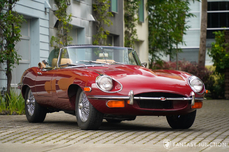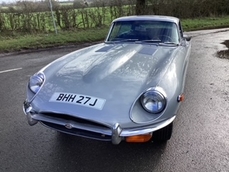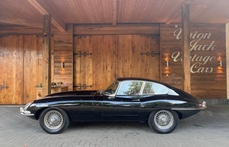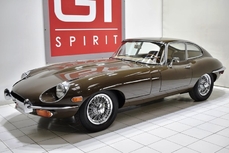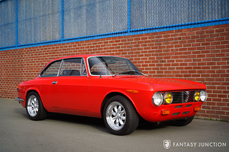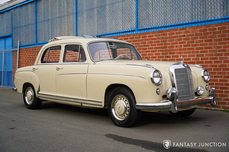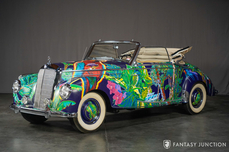Jaguar E-type 3.8 Litre Inline 6-Cylinder no. RA-2461-9 1963
Allgemeine Beschreibung :
1963 Jaguar E-Type Roadster
s/n 879629, engine no. RA2461-9
Opalescent Maroon with Black Leather
The E-Type was unveiled in March of 1961 at the Geneva Motor Show, following the famous 11th hour disorder (one of the cars was driven to the show from England with just hours to spare). The car was an immediate sensation: its specification was state of the art, its performance world-class, its bodywork arrestingly gorgeous, and the price surprisingly affordable. It embodied William Lyons' values beautifully and it is no surprise that the E-Type has become so iconic. The specification clearly reflected Jaguar's sports car racing dominance and included independent suspension all around (at a time when Ferrari was still using live rear axles), disc brakes all around (inboard at the rear to reduce unsprung weight), and of course Jaguar's legendary twin cam inline-6 with triple SU carburetors. Sales were brisk and the cars were continuously developed, although later cars were less pretty and lower performing as a result of new American legislations, while the remarkable twelve cylinder engine of the Series III and accompanying changes made the E-Type less sporting.
Thus, the Series I cars are the most collectable, with the open cars sitting at the top of the heap. This particular roadster is finished in its original color of Opalescent Maroon and retains its original matching-numbers cylinder head and block, per the included Jaguar Daimler Heritage Trust Certificate. The certificate further indicates that the car was dispatched on 2 July 1963 and supplied new to Jaguar of Eastern Canada in Montreal. Its first owner was a D. Gripentrog. By the late 1980s, the car was owned by an attorney in the Chicago area, where it received a comprehensive restoration that was completed in 1991. The body restoration is photo documented, showing that the monocoque was completely stripped and new panels capably installed as necessary. The car’s current condition shows that it has been carefully used in fair weather only since the body restoration was completed.
The owner who commissioned the restoration retained the car for at least ten years, and it passed on to the current owner in 2004, when he purchased it in the Chicago area. Over the last 15 years and 8,000 miles (including two 1,000 mile rallies), he has thoroughly sorted the car at a cost of approximately $70,000, including fitting a 5-speed transmission (the correct type non-matching 4-speed is included with the car), completely rebuilding the engine, and refurbishing the driveline, suspension, and brakes. Highlights include fitting electronic ignition, Spax shocks, and Dayton 72 spoke stainless wire wheel for tubeless tires in 2005, and a rebuild of the rear end in 2013. In 2014, the car received a full stainless big-bore exhaust including tubular headers. In 2017-2018, over $42,000 of work was performed by Donovan Motorcar Service, the highly regarded Jaguar specialist which is known around the country for their exceptionally well-prepared E-Type vintage racecars. The work they performed on this car included a complete engine rebuild and fitting a 5-speed transmission with new drive shaft. All major engine components were replaced or restored, including new pistons, rings, bearings, valve guides and seats, and rebuilt carburetors. The crankshaft was remachined to accept a modern type rear main seal, and a high performance harmonic balancer fitted as well. The engine work included most ancillaries, including gear reduction starter, oil pump, alternator, new AP clutch, and aluminum flywheel. The head was rebuilt with upgraded Isky camshafts as well. Enlarged Wilwood front brakes were fitted as well (vented front and rear), and the master cylinder, universal joints, wheel bearings, and suspension bushings were also renewed. The engine compartment and trunk were cosmetically restored and the fuel tank refurbished as well. Since the rebuilds, the car received shakedown and a post rebuild service including new engine oil and filter, new transmission fluid, retorqued cylinder head, and general check over. The car has now covered approximately 1,500 miles since the engine rebuild.
The resulting car looks and performs great. The cosmetic presentation remains strong despite having been restored in the early 90s. The paint is glossy and handsome, with good coverage and a few minor blemishes such as small chips to the front of the car and door edges, the occasional small scratch, and a few surface imperfections on the left rear fender. The panels are straight and display good fit. The chrome is generally good, with some swirls and light pitting, but still good presentation, while the wide Dayton wheels are in beautiful condition. The glass and lights are very good to excellent, with a few light scratches in the side windows. The turn signal lenses are European market amber items. The high quality canvas convertible top fits properly and shows virtually no wear, with clear rear window and excellent canvas.
The interior presents nicely and is generally correct in appearance, including instruments, steering wheel, upholstery, and other details. The leather is in good condition, and is nicely mellowed with no major wear or aging other than some waviness on the center armrest piping. The door panels, dash top, and sills are in very good condition, as are the carpets. The instruments are in good unrestored condition, with clean faces and crisp markings and needles. The iconic wood-rimmed E-type steering wheel has survived beautifully, with excellent integrity to the wood and a warmth and patina that makes it a pleasure to handle. The horn button shows some crazing, as do some of the toggle switches that punctuate the aluminum center panel. The Blaupunkt radio is not currently functional and the face plate cover is cracked.
The engine compartment has a high end driver level presentation, with the freshly rebuilt engine and refurbished engine bay giving a crisp and well-unified visual impression. The valve covers, intake system, and carburetor dashpots are all nicely polished, while the head and block are properly painted in silver with gold valley and black respectively. The airbox has correct hammertone finish and the correct glass windscreen washer reservoir is still in place as well. The front suspension and subframe are nicely detailed as well. The trunk is correctly trimmed with tan Ambla while under the plywood floor, the spare tire well and fuel tank are in excellent shape, having both been recently refinished.
The underside of the car is very clean and is also structurally excellent, with the high quality of the restoration work clearly evident in both the structure of the car and its mechanical components. Suspension and driveline are excellent, as are the engine and transmission. The car comes with spare wheel, original jack, tool kit, original top boot, car cover with bag and approximately thirty years of invoices for restorative and maintenance work, and photos from the body restoration. Also included are numerous mechanical components including 4-speed transmission, all four original brake calipers, distributor, starter, generator, flywheel, exhaust manifold, fan, and harmonic balancer.
The car runs and drives superbly, with an exceptional, well-resolved character that differentiates this E-Type from less competently maintained and restored examples. Every aspect of the car is a pleasure to use. The engine starts easily warm and cold, with correctly functioning choke and excellent carburetion, oil pressure, and throttle response. The exhaust note is slightly more aggressive than stock but still extremely livable. The gearbox is a pleasure to use, with easy synchromesh and precise linkage, while the clutch has a progressive but positive character. The tall 5th gear allows relaxed cruising, while the sensibly spaced remaining ratios provide brisk acceleration. Suspension setup is extremely well-judged, with a tight, solid feel coupled with good compliance. Steering is free of untoward play, while the additional grip of the wider wheels and tires adds a sure-footed confidence to the car’s dynamic chassis. Brakes are effective and confidence inspiring, with a natural, linear character that matches the spirit of the car’s other upgrades. In short, the car feels very much like an E-Type, but with meaningful improvements in virtually every dynamic aspect, which makes it all the more pleasurable to use in modern traffic.
This is a superb opportunity to acquire a wonderfully sorted E-Type that would be ideal to use extensively. The recipient of significant recent mechanical work and a host of thoughtful upgrades, the car drives great and is cosmetically handsome but not so nice that the new owner would hesitate to drive it on any trip or tour. Comprehensively documented and complete with a significant cache of original parts, this E-Type retains its matching-numbers block and head, and represents the ideal car for the enthusiast seeking a car to use and enjoy.
Please note this car is titled as a 1964.
http://fantasyjunction.com/cars/2208-Jaguar%20-E-Type%20Series%20I-3.8%20Litre%20Inline%206-Cylinder
1963 Jaguar E-type 3.8 Litre Inline 6-Cylinder no. RA-2461-9 is listed verkauft on ClassicDigest in Emeryville by Fantasy Junction for $159500.
Fakten der Auto
Karosserietyp : Auto Marke : Jaguar Modell : E-type Ausführung : 3.8 Litre Inline 6-Cylinder no. RA-2461-9 Hubraum : 3.8 Modelljahr : 1963 Lage : Emeryville
Verkauft
Angaben Zum Verkäufer
Verkauft
People who viewed this Jaguar E-type also viewed similar Jaguar listed at ClassicDigest
Other cars listed for sale by this dealer
über Jaguar
Ah, die Geschichte von Jaguar, von seinen Anfängen als SS Cars Ltd. bis hin zum Höhepunkt mit dem D-Typ und der Straßenversion des ikonischen E-Typs. An dieser Erzählung haftet etwas zutiefst Britisches, und ich werde sie erzählen, wie es ein britischer Journalist tun würde.Die Anfänge:
Unsere Reise in die Welt von Jaguar beginnt in den 1930er Jahren, als ein Unternehmen namens SS Cars Ltd. auftauchte. Trotz des unglücklichen Zufalls ihrer Initialen, die mit den aufkommenden politischen Spannungen in Europa zusammenfielen, begannen sie, stilvolle und leistungsorientierte Autos herzustellen. Der SS 100, der 1936 eingeführt wurde, war ein Symbol für Eleganz und Geschwindigkeit und legte den Grundstein für das, was Jaguar werden sollte.
Die Geburt von Jaguar:
Als der Schatten des Zweiten Weltkriegs näher rückte, entschied sich SS Cars Ltd. klugerweise, sich von den SS-Initialen zu distanzieren. So wurden sie 1945 offiziell zu Jaguar Cars Ltd., ein Name, der bald für britischen Luxus und Leistung stehen würde.
Die XK-Serie:
Die Nachkriegszeit von Jaguar brachte uns den XK 120, eine wahre Sensation im Jahr 1948. Mit seinem schlanken Design und einem leistungsstarken 3,4-Liter-Sechszylindermotor wurde er zum schnellsten Serienauto der Welt. Der XK 120 war die Blaupause für das, was kommen würde - Jaguars, die Stil mit Geschwindigkeit auf einzigartig britische Weise verbanden.
Die Dominanz des D-Typs:
Dann kam der D-Typ, eine wahre Rennlegende. 1954 eingeführt, gewann er in den 1950er Jahren dreimal Le Mans und zeigte die technische Kompetenz von Jaguar. Mit seiner innovativen Monocoque-Konstruktion und der ikonischen Finne hinten war der D-Typ der Höhepunkt von Jaguars Motorsporterfolgen.
Das Auftauchen des E-Typs:
Aber der wahre Wendepunkt kam 1961 mit der Einführung des E-Typs, oft von Enzo Ferrari als "das schönste Auto, das je gebaut wurde" bezeichnet. Seine lange Motorhaube, die geschwungene Karosserie und ein 3,8-Liter-Motor, der atemberaubende Leistung lieferte, machten ihn sofort zu einem Klassiker. Der E-Typ war nicht nur ein Auto; er war ein Kunstwerk auf Rädern und konnte auf der Straße 150 Meilen pro Stunde erreichen.
Straßen- und Rennsporterfolge:
Die Schönheit des E-Typs wurde durch seine Leistung auf der Rennstrecke unterstrichen. Die leichten E-Typen waren bei verschiedenen Rennveranstaltungen besonders erfolgreich und festigten den Ruf von Jaguar als eine Kraft, mit der man im Motorsport rechnen musste.
Das Zeitalter der Raffinesse:
Je tiefer wir in die Geschichte von Jaguar eintauchen, desto mehr erkennen wir, dass die 1950er und 1960er Jahre ein Zeitalter der Raffinesse und Expansion waren. Neben dem großartigen D-Typ und dem ikonischen Aufstieg des E-Typs führte Jaguar Modelle ein, die seinen Ruf für Luxus und Leistung weiter festigten.
Der MK2:
Ende der 1950er Jahre stellte Jaguar den MK2 vor, eine Sportlimousine, die Eleganz mit Leistung vereinte. Diese elegante viertürige Limousine war sowohl bei Bankräubern als auch bei der Polizei aufgrund ihrer außergewöhnlichen Geschwindigkeit und Handhabung beliebt. Der MK2 war ein Symbol für Jaguars Fähigkeit, Raffinesse mit Leistung zu verbinden und hatte auch eine erfolgreiche Rennkarriere.
Der XJ6:
Springen wir ins Jahr 1968, als Jaguar ein Auto auf den Markt brachte, das Jahrzehnte lang Luxuslimousinen definieren würde - den XJ6. Es war ein Meisterwerk der Ingenieurkunst und des Designs, mit einem sanften Reihensechszylindermotor, unabhängiger Hinterachse und einem geräumigen, wunderschön ausgestatteten Innenraum. Der XJ6 war ein Symbol britischer Eleganz und bot eine so sanfte Fahrt, dass es schien, als würde er förmlich über die Straße gleiten. Er wurde zum Flaggschiffmodell für Jaguar und setzte den Maßstab für Luxuslimousinen und zeigte ein Maß an Raffinesse, das die Konkurrenz staunen ließ.
Die Verschmelzung von Klassik und Moderne:
Während der MK2 und der XJ6 die Evolution der Limousinen von Jaguar repräsentierten, bewahrten sie das Engagement der Marke für Leistung und Luxus. Diese Autos gehörten nicht nur auf die Rennstrecke; sie fühlten sich genauso wohl auf den Prachtstraßen wie auf einer entspannten Fahrt durch die englische Landschaft.
Die Herausforderungen des Wandels:
Dennoch sah sich Jaguar mit dem Eintritt der 1970er Jahre, wie viele britische Automobilhersteller, finanziellen Herausforderungen und Veränderungen in der Eigentümerschaft gegenüber. Die Ära von British Leyland brachte sowohl Chancen als auch Schwierigkeiten mit sich, während die Marke durch verschiedene Fusionen und Übergänge navigierte.
Das Erbe des MK2 und des XJ6, zusammen mit dem D-Typ und dem E-Typ, definiert Jaguar weiterhin als einen Hersteller, der zeitlose Eleganz mit einer Leistungsstärke vereint. Diese klassischen Modelle, ob sie über kurvige Straßen gefahren oder als Sammlerschätze geparkt werden, dienen als Zeugnis für die anhaltende Präsenz von Jaguar in der Welt der automobilen Exzellenz.
Die Jaguar-Geschichte, von ihren Anfängen als SS Cars Ltd. bis zur Schaffung von Automobilikonen wie dem E-Typ, dem MK2 und dem XJ6, ist eine Reise, die das Wesen des britischen Automobilbaus widerspiegelt - eine Mischung aus Luxus, Leistung und Stil, die nach wie vor Enthusiasten und Kenner gleichermaßen fasziniert.


